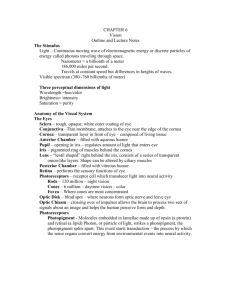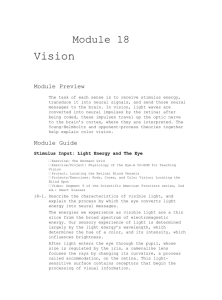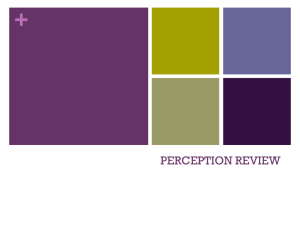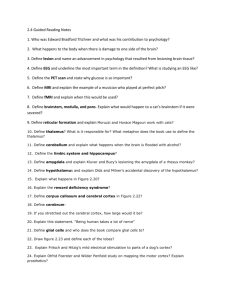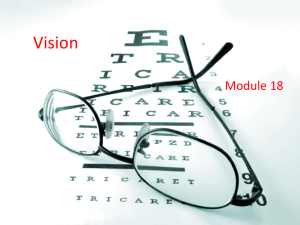Introduction to vision - Pigments and perception
advertisement
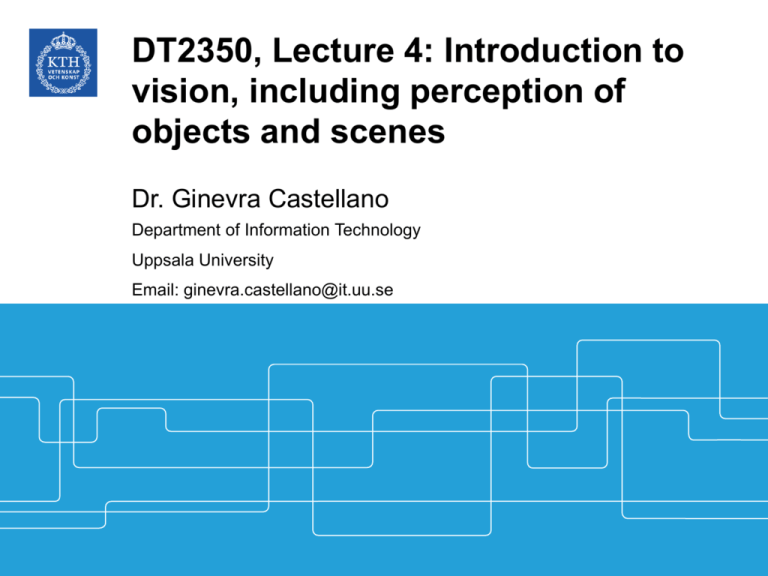
DT2350, Lecture 4: Introduction to vision, including perception of objects and scenes Dr. Ginevra Castellano Department of Information Technology Uppsala University Email: ginevra.castellano@it.uu.se Textbooks • Goldstein, E. (2009). Sensation and Perception. • Weinschenk, S.M. (2011). 100 Things Every Designer Needs to Know About People. Overview • Introduction to vision • What happens at the very beginning of the visual system • The visual cortex and beyond • Processes that occur in the visual areas of the brain • Perceiving objects and scenes • How do we distinguish objects from their background? Introduction to vision - Focusing light onto the retina • Vision begins when visible light is reflected from objects into the eye • • Wavelength Photons Electromagnetic spectrum Introduction to vision - Focusing light onto the retina • Light entering through the pupil is focused by the cornea and lens to form images on the retina • The lens can change its shape to adjust the eye’s focus for stimuli located at different distances (accomodation) Introduction to vision - Transforming light onto electricity • Transduction is carried out by receptors (rods and cones) via visual pigments molecules Introduction to vision - Transforming light onto electricity • Retinal is the part of the visual pigment that is sensitive to light • Isomerization -> activation of the entire receptor Introduction to vision - Pigments and perception • Distribution of rods and cones (120 vs. 6 million) • • • Fovea contains only cones When we look directly at an object, its image falls on the fovea Blind spot: no receptors where the optic nerve leaves the eye Introduction to vision - Pigments and perception • Dark adaptation of the rods and cones • Increase eye sensitivity in the dark • Two different stages • Initial rapid stage – • Cone receptors Second slower stage – Rod receptors Introduction to vision - Pigments and perception Introduction to vision - Pigments and perception • Spectral sensitivity curves for rods and cones • • Rods are more sensitive to short wavelength light than are the cones The cones are more sensitive in the light, and the rods are more sensitive in the dark Introduction to vision - Neural convergence and perception • Neural convergence • From receptors to ganglion cells Introduction to vision - Neural convergence and perception • Neural convergence • When one neuron receives signals from many other neurons Circuit with no convergence Circuit with convergence Introduction to vision - Neural convergence and perception • Signals from the rods converge more than do the signals from the cones • • 120 rods to one ganglion cell vs 6 cones to a ganglion cell The rods result in better sensitivity than the cones • Signals from the cones converge less than do the signals from the rods • • The cones result in better detail vision (visual acuity) than the rods Visual acuity is highest in the fovea (rich in cones); objects that are imaged on the peripheral retina are not seen as clearly Introduction to vision - Lateral inhibition and perception • Lateral inhibition Lateral inhibition arrives at neuron B from A and from C; neuron B responds best when just the center receptors (3–5) are stimulated Introduction to vision - Lateral inhibition and perception • Perceptual effects of lateral inhibition • Perception of lightness – Perception of shades ranging from white to grey to black • The Hermann Grid: seeing spots at intersections Introduction to vision - Lateral inhibition and perception • How the dark spots at the intersections can be explained by lateral inhibition Assumption: The lateral inhibition sent by each receptor’s bipolar cell is one-tenth of each receptor’s response The visual cortex and beyond Following the signal from retina to cortex • Overview of the visual system The visual cortex and beyond Following the signal from retina to cortex • Processing in the lateral geniculate nucleus (LGN) The visual cortex and beyond Following the signal from retina to cortex • Signals arriving at the LGN are sorted and organized based on • • • the eye they came from the receptors that generated them the type of environmental information that is represented in them • LGN is a bilateral structure • one LGN in the left hemisphere and one in the right hemisphere The visual cortex and beyond Following the signal from retina to cortex • Organisation as a spatial map • • Retinotopic map A map in which each point on the LGN corresponds to a point on the retina The visual cortex and beyond Following the signal from retina to cortex • Receptive Fields of Neurons in the Striate Cortex • Simple, complex and end-stopped cells – Fire in response to specific features of the stimulus – E.g., orientation or direction of movement – Feature detectors The visual cortex and beyond - Do feature detectors play a role in perception? • When we view a stimulus with a specific property, neurons tuned to that property fire • Selective adaptation • if the neurons fire for long enough, they become fatigued, or adapt – – the neuron’s firing rate decreases the neuron fires less when that stimulus is immediately presented again The visual cortex and beyond - Maps and columns in the striate cortex • Retinotopic mapping indicates that information about objects near each other in the environment is processed by neurons near each other in the cortex • Maps in the striate cortex The visual cortex and beyond - Maps and columns in the striate cortex • Cortical magnification factor • The area representing the cone-rich fovea is much larger than one would expect from the fovea’s small size • Even though the fovea accounts for only 0.01 percent of the retina’s area, signals from the fovea account for 8 to 10 percent of the retinotopic map on the cortex The visual cortex and beyond - Maps and columns in the striate cortex • The cortex is organized into a number of different kinds of columns The visual cortex and beyond - Maps and columns in the striate cortex • How is an object represented in the striate cortex? The visual cortex and beyond - Streams: pathways for what, where and how • Streams that transmit information from the striate cortex to other areas in the brain • The what pathway (the ventral pathway) – From the striate cortex to the temporal lobe – Identifying objects • The where (how) pathway (the dorsal pathway) – From the striate cortex to the parietal lobe – Locating objects – Taking action The visual cortex and beyond - Modularity: structures for faces, places and bodies • Fusiform face area (FFA) • • Activated by faces Located in the Fusiform Gyrus The visual cortex and beyond - Modularity: structures for faces, places and bodies • Parahippocampal place area (PPA) • Sensitivity to indoor and outdoor scenes • Extrastriate body area (EBA) • Activated by pictures of bodies and parts of bodies (but not by faces) • Located in the temporal cortex Perceiving objects and scenes - Why is it so difficult to design a perceiving machine? • The stimulus on the receptors is ambiguous Perceiving objects and scenes - Why is it so difficult to design a perceiving machine? • Objects can be hidden or blurred Perceiving objects and scenes - Why is it so difficult to design a perceiving machine? • Objects look different from different viewpoints Perceiving objects and scenes - The Gesthalt approach to object perception • Rejecting the idea that perception is built up of sensations • Perceptual organisation • • Grouping elements in an image to create larger objects Six laws to explain how perceptual grouping occurs Perceiving objects and scenes - The Gesthalt approach to object perception • Law of pragnanz • Every stimulus pattern is seen in such a way that the resulting structure is as simple as possible Perceiving objects and scenes - The Gesthalt approach to object perception • Law of similarity • Similar things appear to be grouped together Perceiving objects and scenes - The Gesthalt approach to object perception • Law of good continuation • Points that, when connected, result in straight or smoothly curving lines are seen as belonging together, and the lines tend to be seen in such a way as to follow the smoothest path Perceiving objects and scenes - The Gesthalt approach to object perception • Law of proximity • Things that are near each other appear to be grouped together • Law of common fate • Things that are moving in the same direction appear to be grouped together Perceiving objects and scenes - The Gesthalt approach to object perception • Law of familiarity • Things that form patterns that are familiar or meaningful are likely to become grouped together Perceiving objects and scenes - The Gesthalt approach to object perception • Perceptual segregation: how objects are separated from the background Perceiving objects and scenes - The Gesthalt approach to object perception • What are the properties of figure and ground? • The figure is more “thinglike” and more memorable than the ground • The figure is seen as being in front of the ground • The ground is seen as unformed material and seems to extend behind the figure • The contour separating the figure from the ground appears to belong to the figure Perceiving objects and scenes - The Gesthalt approach to object perception • What factors determine which area is figure? • Regions in the lower part of a display are more likely to be perceived as figure than regions in the upper part Perceiving objects and scenes - Perceiving scenes and objects in scenes • A scene is a view of a real-world environment that contains (1) background elements and (2) multiple objects that are organized in a meaningful way relative to each other and the background • Perceiving the gist of a scene is possible within a fraction of a second Perceiving objects and scenes - Perceiving scenes and objects in scenes • What enables observers to perceive the gist of a scene so rapidly? • Global image features (Oliva and Torralba, 2006) – Degree of naturalness; degree of openness; degree of roughness; degree of expansion; colour Perceiving objects and scenes - Perceiving scenes and objects in scenes • We easily use our knowledge of regularities in the environment to help us perceive, even though we may not be able to identify the specific information we are using • Physical regularities – Regularly occurring physical properties of the environment people can perceive horizontals and verticals more easily than other orientations • Semantic regularities – Meaning of a scene Perceiving objects and scenes - The physiology of object and scene perception • Neurons that respond to perceptual grouping Perceiving objects and scenes - The physiology of object and scene perception • How does the brain respond to objects? • Distributed activity across the brain • Fusiform face area (FFA) • • A face might cause a large amount of activity in the FFA, but also cause activity in other areas as well Firing is, therefore, distributed in two ways: – – across groups of neurons within a specific area across different areas in the brain “Design” case study: There’s a special part of the brain just for recognising faces • There’s a special part of the brain just for recognising faces • People are born for a preference for faces • Fusiform face area (FFA) (Kanwisher, 1997; 2000) – Outside visual cortex – Recognise faces – Helps us identify faces more quickly than objects – People with autism do not use FFA to identify faces (Pierce, 2001) Kanwisher, N. (2000). Domain specificity in face perception. Nature, 3, 759–763. We look where the face looks • Eye tracking research shows that if a picture of a face looks away from us and toward a product on a web page, we tend to also look at the product • Establish emotional connection vs directing attention Weinschenk, S.M. (2011). 100 Things Every Designer Needs to Know About People. People decide who and what is alive by looking at the eyes • Looser and Wheatley (2010) took pictures of people and then morphed them in stages into inanimate mannequin faces • Subjects say the pictures no longer show someone who is alive at about the 75 percent mark People primarily use the eyes to decide if a picture shows someone who is human and alive Video 1; video 2 • • Weinschenk, S.M. (2011). 100 Things Every Designer Needs to Know About People. Take away messages • People recognize and react to faces on Web pages faster than anything else on the page (at least by those who are not autistic) • Faces looking right at people will have the greatest emotional impact on a Web page, probably because the eyes are the most important part of the face • If a face on a Web page looks at another spot or product on the page, people will also tend to look at that product. This doesn’t necessarily mean that they paid attention to it, just that they physically looked at it. Weinschenk, S.M. (2011). 100 Things Every Designer Needs to Know About People. References • Goldstein, E. (2009). Sensation and Perception. • Weinschenk, S.M. (2011). 100 Things Every Designer Needs to Know About People. Contact Dr. Ginevra Castellano Department of Information Technology Uppsala University Email: ginevra.castellano@it.uu.se
